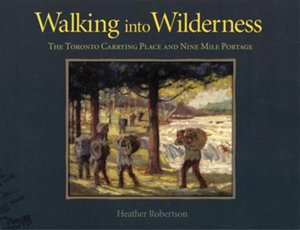Walking into Wilderness: The Toronto Carrying Place and Nine Mile Portage

Support Canada's History in other ways (more)
by Heather Robertson
Heartland Associates, Winnipeg, 2010
224 pp., illus., $29.95 paperback
As part of her research into her book Walking Into Wilderness, Heather Robertson walked, drove, canoed, and took part in an archaeological field survey, retracing the steps taken by Aboriginals and by early European explorers along what was once an important trail linking Lake Ontario to Lake Huron. Her travels through what are now residential areas, industrial parks, farm fields, and forests set up the story of who passed this way in earlier eras.
The forty-six-kilometre walking part of the trail starts at the mouth of the Humber River, in what is now Toronto, and goes up and over the Oak Ridges Moraine to a water route that begins at the West Holland River. Over this long portage, people like Étienne Brulé laboriously carried their trade goods and canoes. Brulé, the first European to explore the Huron region, first arrived here in 1610.
Readers learn of the famous and infamous people (Brulé was both) connected with this route through source material such as the Champlain’s writings, The Jesuit Relations, and other writings of the period, which are interspersed with Robinson’s own voice: Thus, if the young and adventurous Brulé were alive today, “he’d be snuggled up with a sexy babe. He would not be at Mass.”
This richly illustrated book tells of the comings and goings along the route during the fur trade, the War of 1812, the settlement period, and, more recently, the development of Holland Marsh and the destruction wrought by Hurricane Hazel. In fact, many of the key events in Canada’s history took place along this route.
This review appeared in the August-September 2012 issue of Canada's History magazine.
— Nelle Oosterom (Read bio)
Nelle Oosterom is the Senior Editor of Canada's History magazine.